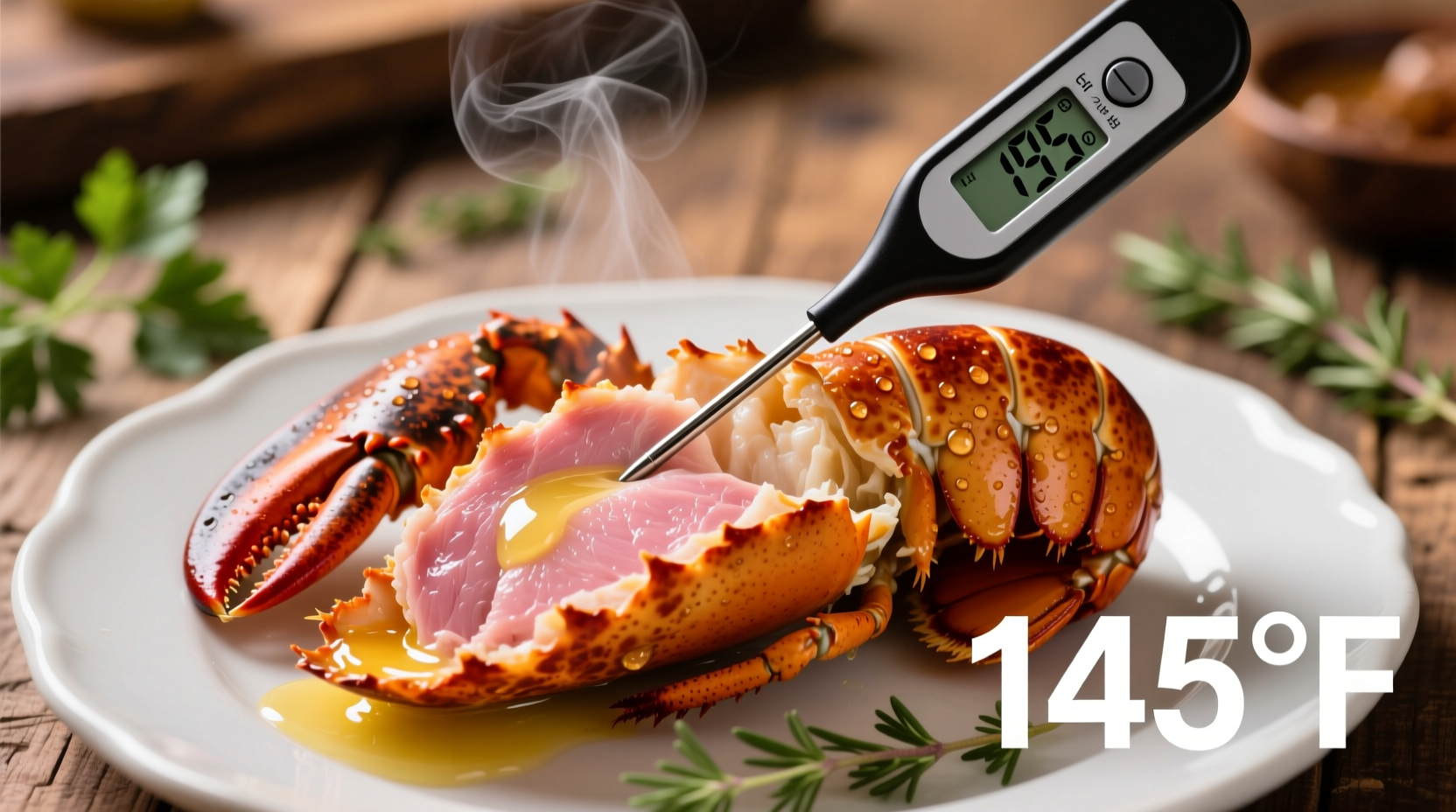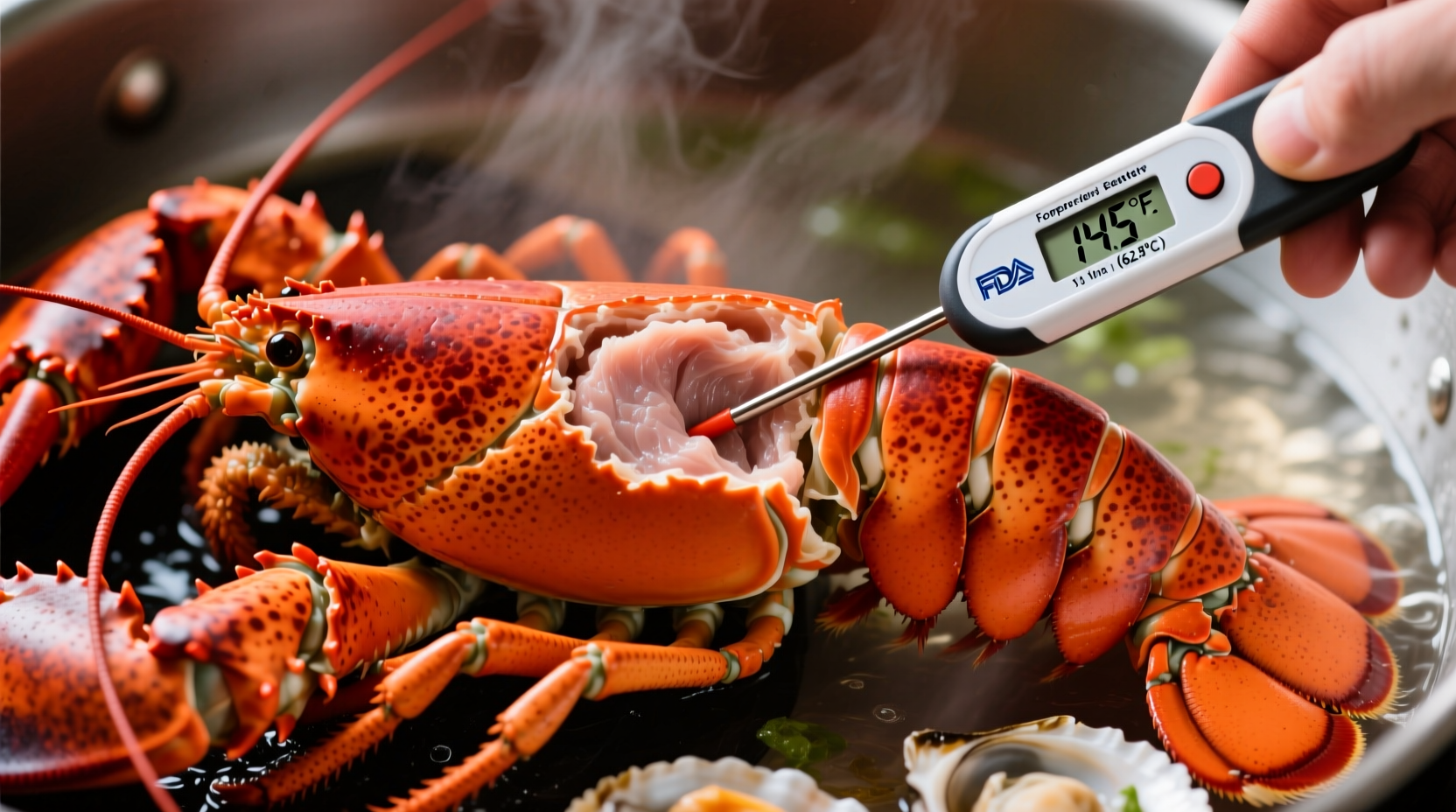The minimum internal cooking temperature for whole lobster is 145°F (63°C), measured in the thickest part of the meat. This temperature ensures the lobster is safe to eat while maintaining optimal texture and flavor.
Getting your lobster perfectly cooked isn't just about flavor—it's a critical food safety issue. Undercooked lobster can harbor harmful bacteria like Vibrio, putting you and your guests at risk. As someone who's worked in professional kitchens for over 15 years, I've seen too many home cooks guess their way through seafood preparation. Let's get this right—your health depends on it.
Why 145°F Is the Safety Threshold
The USDA Food Safety and Inspection Service and FDA Food Code both specify 145°F as the minimum safe internal temperature for all shellfish, including whole lobster. At this temperature, dangerous pathogens like Vibrio parahaemolyticus and Vibrio vulnificus are effectively destroyed.
These bacteria naturally occur in coastal waters where lobsters live. While cooking lobster alive reduces some risks, proper internal temperature remains essential for safety. The 145°F standard provides a 7.0 log10 reduction in Vibrio bacteria, making the seafood safe for consumption.

How to Accurately Measure Lobster Temperature
Proper temperature measurement is more nuanced than simply poking a thermometer into your lobster. Follow these professional techniques:
- Use an instant-read digital thermometer (not dial thermometers) for precision within ±0.5°F
- Target the thickest part of the tail meat, avoiding contact with the shell
- Wait 10 seconds for the reading to stabilize before recording
- Check multiple spots in larger lobsters (over 1.5 lbs)
Many home cooks make the mistake of checking temperature too early in the cooking process. For boiling or steaming, wait until the shell turns bright red and the meat begins to separate from the shell before taking your first temperature reading.
Cooking Methods and Temperature Management
Different cooking techniques require slight adjustments to achieve that perfect 145°F internal temperature:
| Cooking Method | Target Time | Temperature Check Timing | Carryover Cooking |
|---|---|---|---|
| Boiling | 8-12 minutes | Remove 2-3 minutes before target time | +5-8°F |
| Steaming | 10-14 minutes | Remove 3-4 minutes before target time | +3-5°F |
| Grilling | 6-10 minutes | Check when shell turns red | +5-10°F |
| Baking | 12-18 minutes | Check at 75% of cooking time | +3-7°F |
Carryover cooking (residual heat continuing to cook the food after removal from heat) is significant with dense lobster meat. Always remove lobster from heat when it reaches 138-140°F, allowing it to coast to the safe 145°F threshold during resting.
Visual Doneness Indicators Beyond Temperature
While temperature is the only reliable safety indicator, these visual cues confirm proper cooking:
- Shell color: Bright red or orange (greenish shells indicate undercooking)
- Meat texture: Pearly white and opaque, not translucent
- Tail curl: Natural curl when cooked properly
- Leg joints: Meat pulls away cleanly from shell
Never rely solely on visual cues for food safety—these should complement, not replace, thermometer use. The USDA emphasizes that color and texture alone cannot guarantee pathogen elimination.
Avoiding Common Lobster Cooking Mistakes
Based on my experience teaching home cooks, these temperature-related errors happen most frequently:
- Thermometer placement error: Inserting too close to shell (reads higher than actual meat temperature)
- Insufficient resting time: Cutting into lobster immediately, causing juices to escape
- Overcooking prevention obsession: Stopping at 140°F out of fear of toughness (unsafe)
- Ignoring size variables: Cooking a 2-lb lobster the same as a 1-lb lobster
Remember that larger lobsters require longer cooking times but should still reach the same 145°F internal temperature. A 2-lb lobster might need 14 minutes of boiling versus 9 minutes for a 1-lb lobster, but both must hit that critical safety threshold.
Special Considerations for Food Safety
Certain situations require extra temperature vigilance:
- Warm weather cooking: When ambient temperatures exceed 90°F, bacteria multiply faster—ensure lobster reaches 145°F within 2 hours of preparation
- Leftover safety: Refrigerate cooked lobster within 2 hours (1 hour if above 90°F); reheat to 165°F
- Vulnerable populations: For elderly, pregnant, or immunocompromised individuals, consider cooking to 150°F for additional safety margin
The FDA Food Code (2022) specifically notes that shellfish for high-risk populations should be cooked to 150°F when served immediately, providing an extra safety buffer while maintaining acceptable texture.
Practical Temperature Verification
To verify your thermometer's accuracy before cooking:
- Fill a glass with ice and add cold water
- Stir for 30 seconds to create a consistent 32°F environment
- Insert thermometer probe (not touching glass)
- Wait 30 seconds for reading to stabilize
- Adjust or replace if reading isn't 32°F ±1°F
Regular calibration ensures your temperature readings are reliable. I recommend checking your thermometer before every important cooking session—it's the difference between safe and risky seafood.











 浙公网安备
33010002000092号
浙公网安备
33010002000092号 浙B2-20120091-4
浙B2-20120091-4